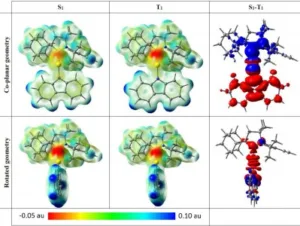Fluorescent Organic Light Emitting Diode (OLED) materials typically have a maximum internal quantum efficiency of about 25%. A team of researchers headed by Dawei Di, a member of the Optoelectronics Group within the Department of Physics at the Cavendish Laboratory (Cambridge, United Kingdom), are attempting to improve upon this by developing a type of OLED material that has an enhanced ability to convert electrical energy into light.
A recent publication by the team on this subject is entitled “High-performance light-emitting diodes based on carbene-metal-amides.” It was published in Science, 2017, Apr 14, vol. 356 no. 6334, 159-163. A copy of the article is available for purchase on-line and can be found here. To start, here are a few words of background information.
Drawing upon commentary in a recent article in Science Daily, here is a top level and simplified summary of the team’s developments.
When an electric current passes through an OLED, the molecules can be put into an excited state. About 25% of these excited states are so-called “bright” states, states capable of rapidly emitting light. The remaining 75% are so-called “dark” states that typically dissipate their energy as heat. The underlying reason for the existence of two states is a quantum property called spin. In the context of OLEDs, the dark states have the wrong type of spin. This, in turn, ultimately limits the efficiency of OLED devices.
One approach to address the spin issue involves the incorporation of rare elements, such as iridium, into the molecular structure of the OLED molecules. Doing so enhances the possibility that the dark states change their spin state thus allowing the molecules to emit light. The problem with this approach is that the time required to change spin state is too long. In OLED technology, too long means that the energy is tied up in the dark state for a length of time sufficient to allow it to build up to a level that damages the OLED.
In the team’s most recent research, the new means adopted to address the spin state issue was to “manipulate the ratio of spin states through a modification of process chemistry.” More specifically, the team’s approach introduced a rotation of the molecular structure, which inverted the spin-state energetics and enhanced OLED performance.
The article contains a great deal of detailed technical information on the formulation and preparation of the new materials, the fabrication of the OLED devices and the measurement of device performance.
The team developed a material in which two different organic molecules are joined together by an atom of copper or gold. The resulting structure is described as looking somewhat like a propeller. “The compounds, which can be made by a simple one-pot procedure from readily available materials, was found to be surprisingly luminescent. By rotating their “propeller,” dark states formed on these materials became twisted, which allows them to change their spin quickly. The process significantly increases the rate at which electrical energy is converted into light achieving an efficiency of almost 100% and preventing the damaging build-up of dark states.”
Perhaps the most interesting illustration included in the technical article appears below. It visualizes structural rotation in several of the molecules included in the study.
Rotation of the molecular structure illustrated by calculated electrostatic potential energy maps for the excited S1 and T1 states.
The team explained that “It’s amazing that the very first demonstration of this new kind of material already beats the performance of technologies which have taken decades to develop. If the effect we have discovered can be harnessed across the spectrum, it could change the way we generate light.” The team envisions that a next step in developing the technology is to “design new molecules that take full advantage of this mechanism, with the ultimate goal of entirely removing the need for rare elements.” -Arthur Berman
Cavendish Laboratory, Dawei Di, [email protected]

